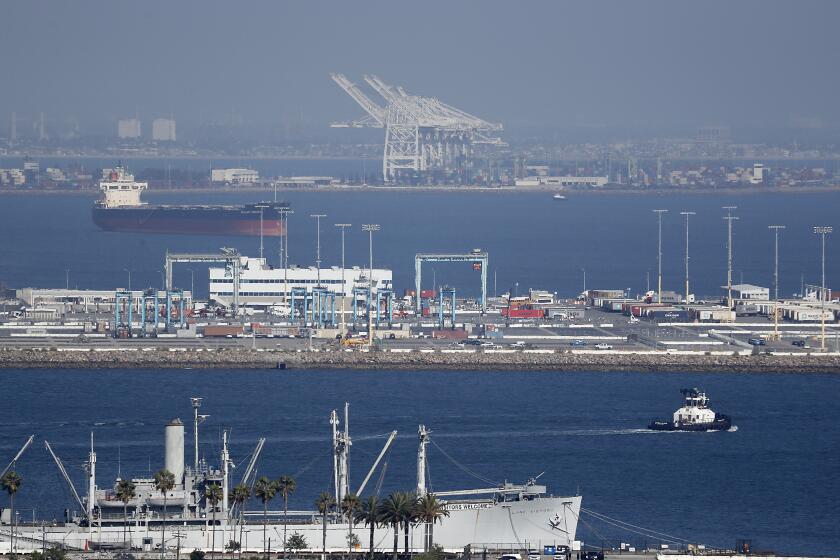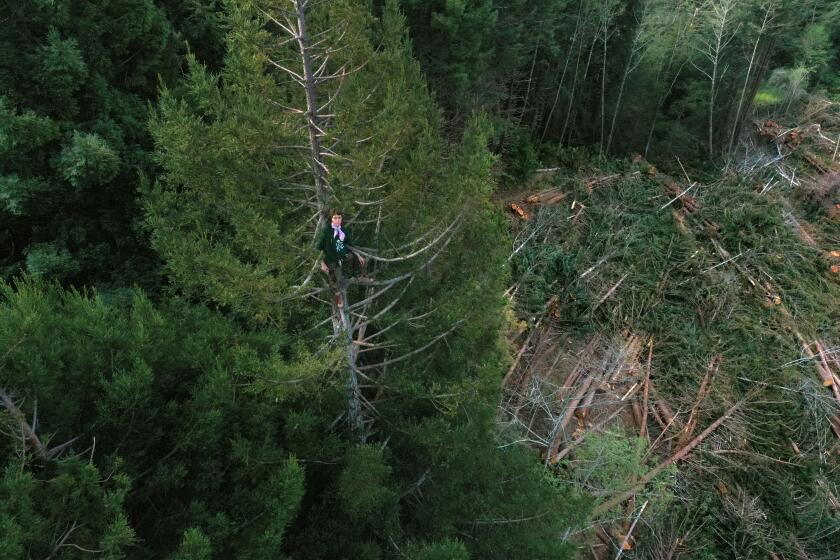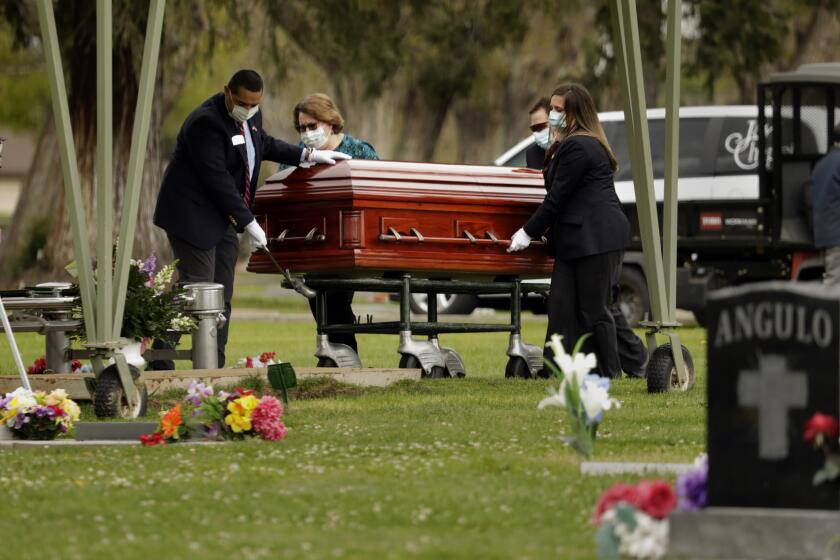
- Share via
The sounds of traffic and airplanes have quieted across much of Los Angeles County and California as health orders keep people indoors.
But if you listen closely, you’ll still hear the whistle of trains as they cart and transport food, consumer products, chemicals and livestock to and from manufacturers, stores and ports across the country.
At the Burlington Northern Santa Fe Railway, or BNSF, transit hub in La Mirada, Russ Abbott, a locomotive engineer, said that when the pandemic first hit, his only clue that life outside the railroad had changed was his quicker commute between home and work.
“It was really fast,” he said, describing the lack of traffic on the roads. “That was different.
“But here, nobody was sick, we kept moving cars and it all felt pretty normal,” he said to a curious visitor sitting in the cab of the 3,800-horsepower BNSF locomotive he was driving on the railroad tracks that parallel Stage Road in this eastern suburb of Los Angeles County.
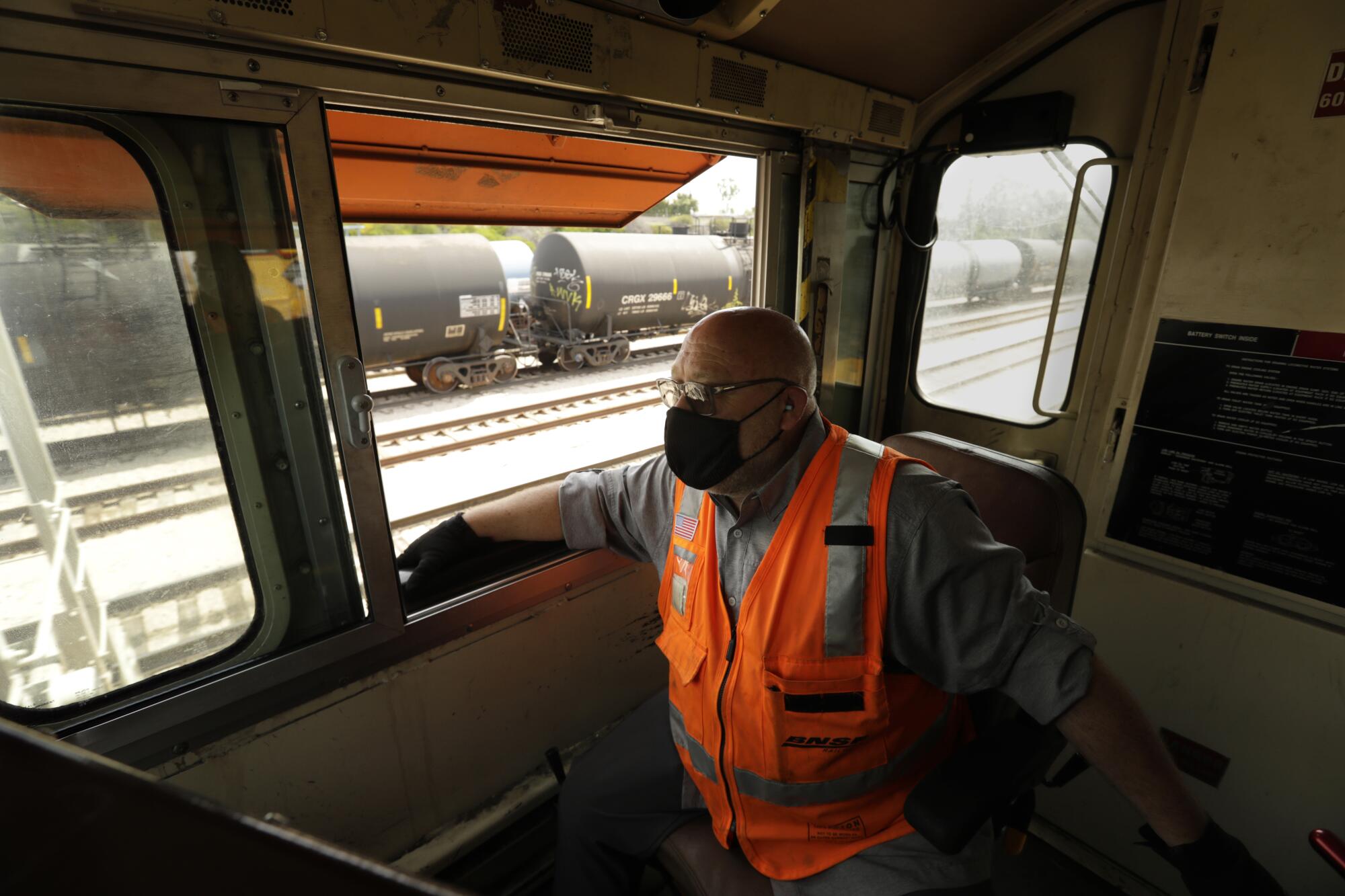
Over the last two months, the COVID-19 pandemic and resulting lockdowns have disrupted supply chains nationwide and have hammered all sectors of the transportation industry. Freight-carrying railroads have also been hit, but not to the degree of airlines and auto manufacturers.
That’s because railroads carry essential items during this pandemic, including frozen meat and vegetable oil, and chemicals such as chlorine bleach and sand for fracking. Abbott bears witness to this supply chain on his workdays, soaking in the clickety-clack of train wheels, carrying thousands of tons of supplies, as they roll over the joints and squats of the rail line.
The nation’s largest port is hurting. That may be a leading indicator of the pain that’s in store for Southern California and the U.S. economy as businesses hunker down to deal with the rapidly expanding new coronavirus.
In La Mirada, those tracks run on a northwest-to-southeast trajectory, behind a Home Depot, International Paper warehouse, and a U.S. Foods outlet. A small spur takes the railway west to an Amazon fulfillment center, a Frito-Lay warehouse and a Staples fulfillment center.
The railroad provides these companies with a direct connection to the coastal ports of Los Angeles and Long Beach, as well as the vast interior of the country.
And while Abbott enjoys moving the trains back and forth among the suppliers and distributors in the county, it’s the Cajon Pass he relishes.
“I still get chills every time I go through it,” he said, describing the picturesque ride through the San Bernardino and San Gabriel mountains, which are now covered with bright poppies and wildflowers. “It never gets old.”
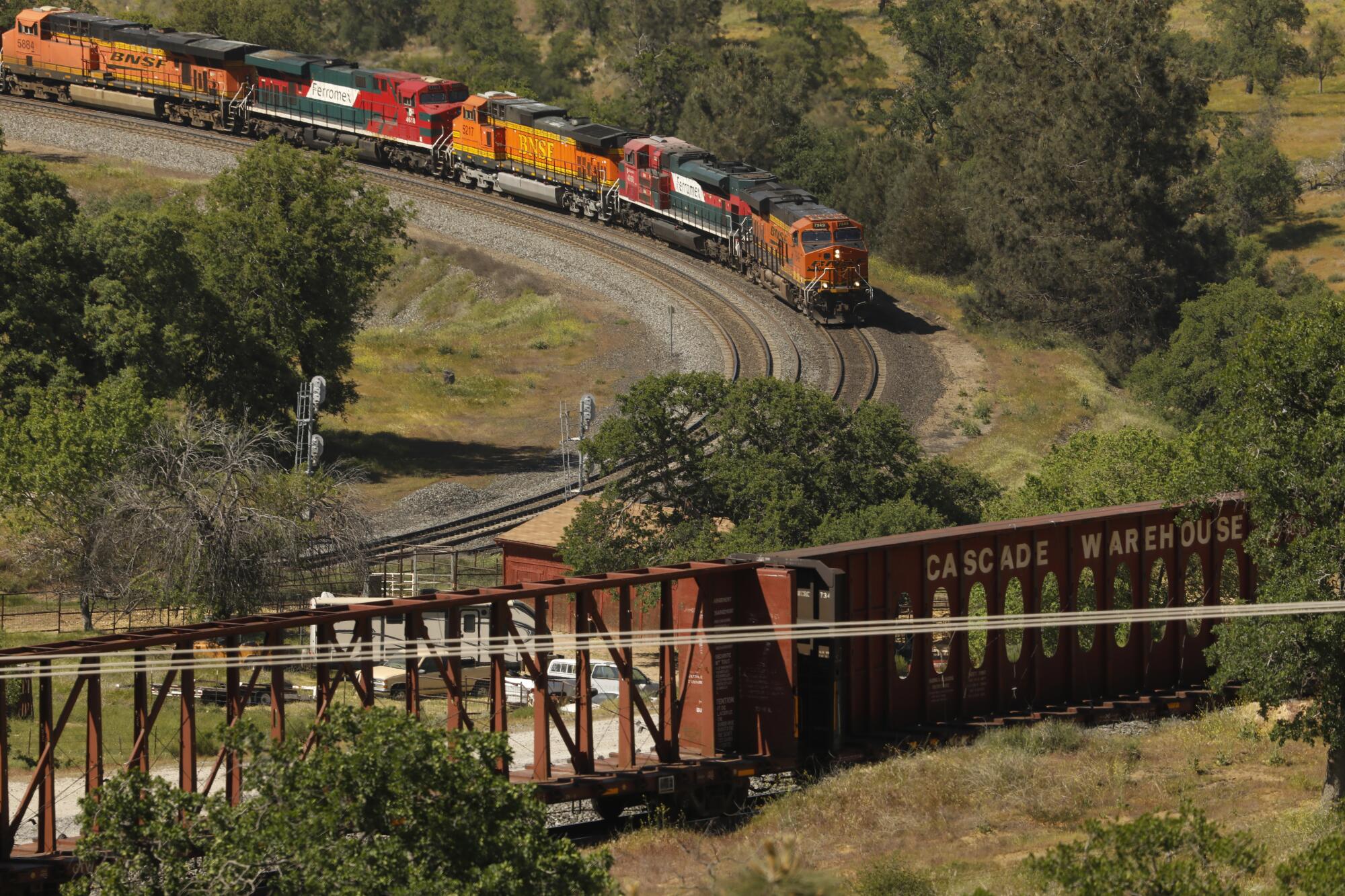
And although Abbott’s day-to-day hasn’t changed drastically since the beginning of the year, there are differences, said Lena Kent, a spokeswoman for BNSF.
Employees now mostly enter information and data via iPads outside, so they don’t have to congregate in the office; trains are wiped down between shifts; and operators and other employees wear masks to prevent the spread of the coronavirus.
“But safety has always been a mainstay,” said Kent, who noted that train crews, who work with powerful moving machinery, are always generally small in number and spread out.

In addition, the volume being moved has shrunk, or in the words of Kent, “softened.”
In La Mirada, the shrinkage is related to a drop in goods coming into the ports of Los Angeles and Long Beach, which have been hit by a combination of trade war disputes and the economic slowdown tied to the coronavirus.
On Thursday, Gene Seroka, the executive director of the Port of Los Angeles, announced at a news conference that movement is 80% of what it was this time last year.
Port statistics show container volume is down 15.5%, and officials predict business will remain “soft” for the next few months.
He noted steep declines in the fast-fashion business, automobiles, scrap metal and steel, with an uptick in produce coming from Latin America.
Coronavirus Journal
Two Times journalists are embarking on a journey throughout California to cover the nation’s most populous and diverse state during the coronavirus crisis.
On the railroads, the movement of auto parts has dropped more than 90% compared with the same week last year.
“We’ve gone from uncertainty” as a result of the trade war “to radical uncertainty,” said Mario Cordero, executive director of the Port of Long Beach. “I don’t think anyone can forecast where we’re going as a nation with our economy. ... I don’t see any normalcy for 2020, or for that matter for 2021. At least in terms of business normalcy.”
Cordero also pointed to the blank sailing statistics, which are the cancellations of scheduled ships. He said in the first quarter of this year, there were 61 blank sailings to the ports of Long Beach and Los Angeles. Forty-eight are expected for this quarter.

“That’s unprecedented,” he said, and it translates to real money and jobs. Without a doubt, that reduction in traffic will affect all sectors of the supply chain, including trains, he said.
Then there’s the drop in demand for coal, which is crippling the economy in the Midwest and mountain states.
Last week, more than 340 BNSF employees were laid off in Montana and Wyoming, where the demand for coal has plummeted. Several BNSF railroad facilities in Montana, Wyoming, Kansas, North Dakota, Wisconsin and Nebraska are now either permanently shuttered or temporarily reduced in size.
And other railroad companies, such as Union Pacific, are getting squeezed by decreased oil and coal demand, according to published reports.
While freight traffic has dropped around the nation, the workload has stayed “relatively steady” at the little hub in La Mirada, Kent said.
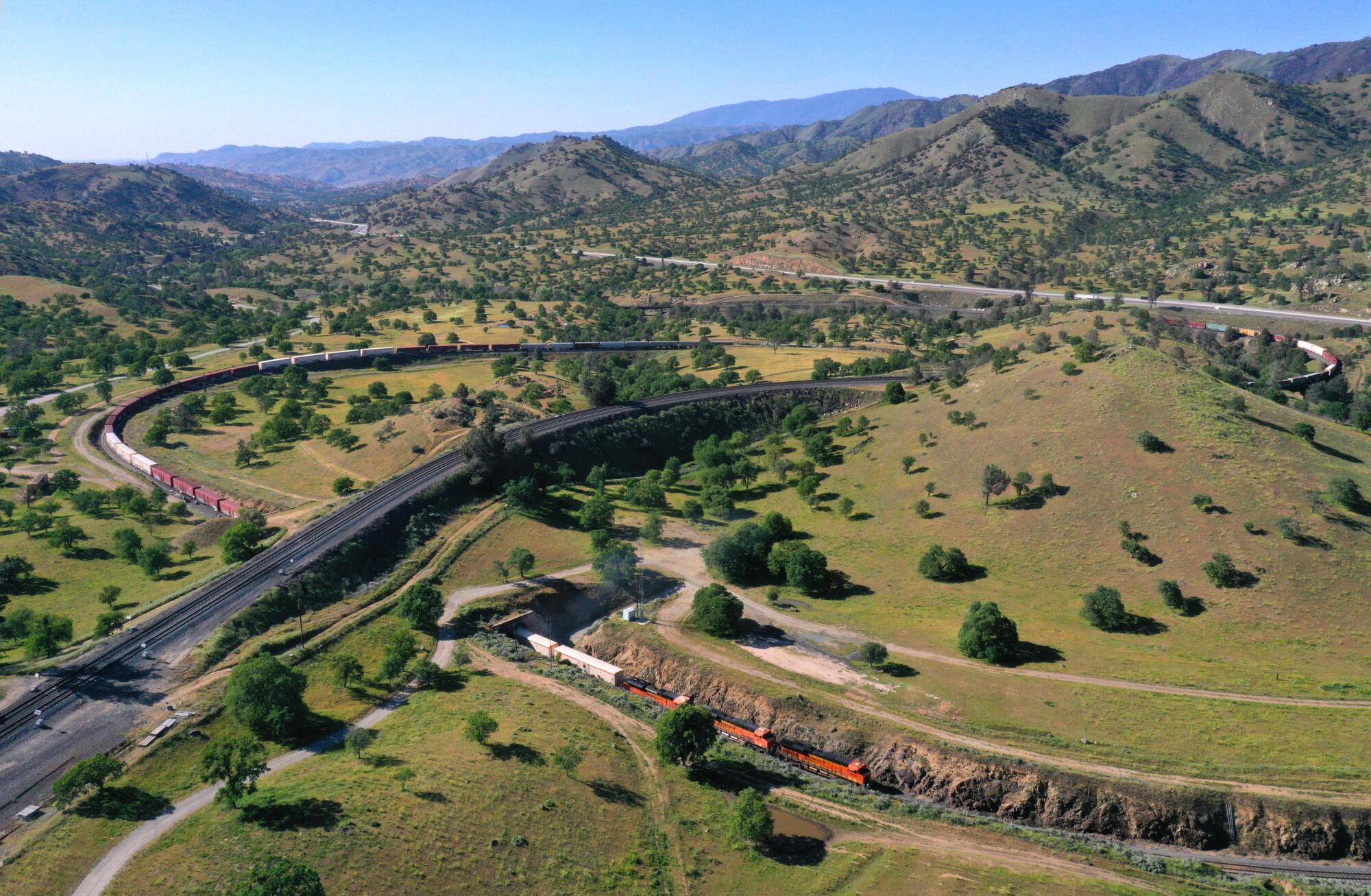
Warren Buffett, whose Berkshire Hathaway owns BNSF, remains bullish about both the U.S. economy and the rail industry, which has a climate footprint just a fraction of that of trucking.
“Nothing can basically stop America,” Buffett said at Berkshire Hathaway’s virtual shareholder meeting early this month. “The American miracle, the American magic has always prevailed and it will do so again.”
Times staff writer Susanne Rust and photographer Carolyn Cole are embarking on a road journey throughout California. They aim to give voice to those in remote parts of the state as they grapple with the worst health and economic calamity of our lifetimes.
More to Read
Sign up for Essential California
The most important California stories and recommendations in your inbox every morning.
You may occasionally receive promotional content from the Los Angeles Times.
